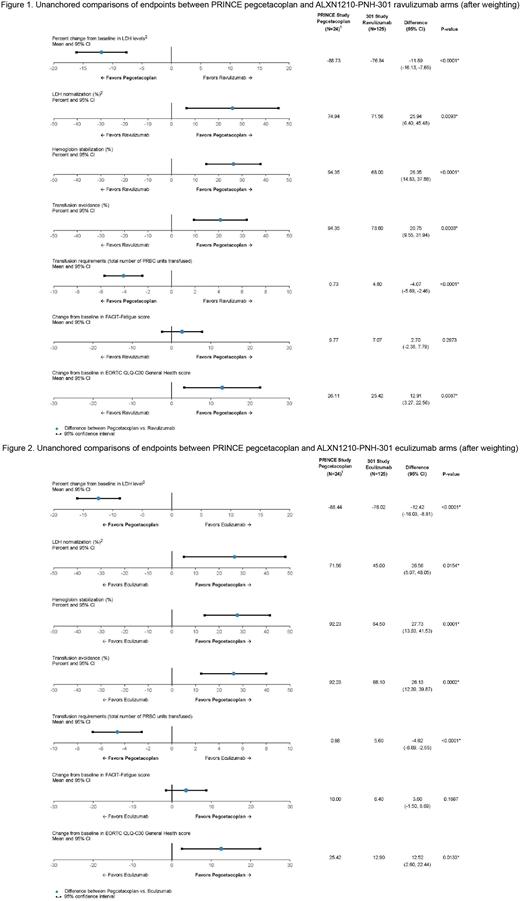Abstract
Introduction Paroxysmal nocturnal hemoglobinuria (PNH) is a rare, chronic, and life-threatening disease characterized by anemia, thrombosis, and bone marrow failure. Currently available treatment options for PNH include the C5 inhibitors eculizumab (ECU) and ravulizumab (RAV), which have been shown to improve clinical outcomes and quality of life for patients with PNH. However, a substantial proportion of patients continue to develop clinical manifestations after initiating treatment with C5 inhibitors. Pegcetacoplan (PEG) is a novel C3 inhibitor approved in the US (2021) and Europe (2021) and has the potential to address this unmet need. However, there is no head-to-head study comparing PEG against either RAV or ECU in complement inhibitor-naïve patients with PNH. The objective of the study is to perform cross-trial comparisons of PEG against both RAV and ECU using unanchored matching-adjusted indirect comparison (MAIC) methods.
Methods Individual patient data from the PRINCE trial (NCT04085601), a randomized, phase 3 study of PEG in complement inhibitor-naïve patients with PNH, were compared to aggregate data from the 301 study (NCT02946463; Lee 2019, PMID: 30510080), another phase 3 study that compared RAV and ECU in a patient cohort having similar eligibility criteria to the PRINCE study. Propensity score weighting was used to adjust for cross-study differences in demographics and baseline characteristics. Unanchored comparisons were assessed for the following outcomes at Week 26: percent change in LDH level from baseline, LDH normalization (LDH <1x ULN [246 U/L]), hemoglobin (Hb) stabilization (avoidance of ≥2 g/dL decrease in Hb level in the absence of transfusions), transfusion avoidance, transfusion requirements, Functional Assessment of Chronic Illness Therapy (FACIT) Fatigue scores, and European Organization for the Research and Treatment of Cancer Quality of Life Questionnaire (EORTC QLQ-C30) General Health scores from baseline. Weighted Wald tests and 95% confidence intervals (CIs) were computed for comparisons of binary and continuous outcomes. To quantify the extent of residual bias from unmeasured confounders, bias factor analysis was used to estimate the bias due to unmeasured confounders for the following binary variables: age≥65 years, overweight or obese, aplastic anemia, impaired renal function, bone marrow failure, and GPI-deficient granulocyte clone size >70%. Unanchored indirect comparisons were adjusted for each bias factor by subtracting the bias factor from the effect estimate and 95% CIs.
Results The analysis included 34 patients treated with PEG from PRINCE, along with 125 and 121 patients treated with RAV and ECU, respectively. Weighting variables included Asian race, age at first infusion, female sex, and baseline EORTC QLQ-C30 general health score. PEG compared favorably to RAV and ECU in unanchored comparisons, with a greater percent reductions in LDH (RAV: mean [95% CI], -11.89 [-16.13, -7.65], p<0.0001; ECU: -12.42 [-16.03, -8.81], p<0.0001); higher percentages of patients achieving LDH normalization (RAV: 25.94 [6.40, 45.48], p=0.0093; ECU: 25.56 [5.07, 48.05], p=0.0154), Hb stabilization (RAV: 26.35 [14.83, 37.86], p<0.0001; ECU: 27.73 [13.93%, 41.53%], p=0.0001), and transfusion avoidance (RAV: 20.75 [9.55, 31.94], p=0.0001; ECU: 26.13 [12.39, 39.87], p=0.0002); as well as lower transfusion requirements, in PRBC units transfused (RAV: -4.07 [-5.69, -2.46], p<0.0001; ECU: -4.62 [-6.69, -2.55], p<0.0001). There were also significant improvements in EORTC QLQ-C30 General Health scores (RAV: 12.91 [3.27, 22.56], p=0.0087; ECU: 12.52 [2.60, 22.44], p=0.0133), but not FACIT-Fatigue scores for both RAV and ECU. Bias factor analysis showed that the results in the MAIC were robust to residual confounding.
Conclusions Using individual patient data from the PRINCE trial and aggregate data from the comparator 301 study, MAIC methods allowed for the examination of the comparative effectiveness of PEG versus RAV and ECU in the absence of head-to-head trials. Results suggest that the use of PEG may lead to improvements in LDH levels, LDH normalization, Hb stabilization, transfusion avoidance, and transfusion requirements, compared to both RAV and ECU. These results were additionally robust to sensitivity analysis using bias factor adjustments.
Disclosures
Wong:Alexion Pharmaceuticals: Consultancy, Honoraria, Research Funding, Speakers Bureau; F. Hoffmann-La Roche AG: Consultancy, Honoraria, Research Funding, Speakers Bureau; Apellis Pharmaceuticals: Research Funding, Speakers Bureau. Fishman:Apellis Pharmaceuticals: Current Employment, Current equity holder in publicly-traded company. Wilson:Swedish Orphan Biovitrum AB: Current Employment, Current equity holder in publicly-traded company. Al-Adhami:Apellis Pharmaceuticals: Current Employment. Yeh:Apellis Pharmaceuticals: Current Employment, Current equity holder in publicly-traded company. Hakimi:Swedish Orphan Biovitrum AB: Current Employment, Current equity holder in publicly-traded company. Yee:Apellis Pharmaceuticals: Research Funding; RTI Health Solutions: Consultancy, Membership on an entity's Board of Directors or advisory committees. Huynh:Appellis Pharmaceuticals: Research Funding; Merck & Co., Inc.: Research Funding; Novartis Services, Inc.: Research Funding. Duh:AstraZeneca: Research Funding; Pharmacyclics: Research Funding; Takeda Oncology: Research Funding; Shire: Research Funding; Merck: Research Funding; Apellis Pharmaceuticals: Research Funding; GSK: Research Funding; Novartis: Research Funding; Blueprint Medicine: Research Funding.
Author notes
Asterisk with author names denotes non-ASH members.


This feature is available to Subscribers Only
Sign In or Create an Account Close Modal